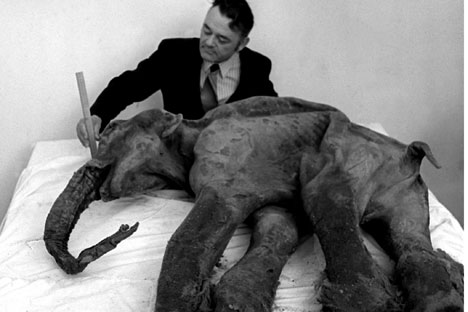Russian scientists plan to clone a mammoth

A scientist measures the fully-preserved carcass of a mammoth found by miners in permafrost near the Kirkish river in the Susumansky district of the Magadan Region, 1977. Source: ITAR-TASS
In Yakutia, one of the northernmost regions of Russia, the International Centre for the Collective Use of Molecular Palaeontology for the Study of Cells of Prehistoric Animals will open in September as part of the Mammoth Resurrection project.
The researchers should have plenty of material to work with. Seventy five percent of the world's known mammoth remains have been found in remote areas of Yakutia. Every year, the ice yields new animal remains. After the laboratory is upgraded with the necessary equipment for genetic research, the scientists will start work on isolating DNA and cloning mammoths.
Mammoth Resurrection project
In 2012, the directors of the Lazarev Mammoth Museum of Northeastern Federal University's Institute of Applied Ecology and Soam, a Korean foundation for biotechnology research, agreed to cooperate on the Mammoth Resurrection project.
According to the head of the museum Semyon Grigoriev, the international centre was established as a Yakutia-Korean laboratory. The Korean partners have purchased several million dollars' worth of equipment, and Northeastern Federal University has offered and remodelled rooms that the scientists will need for their work. Russian scientists have been studying mammoth DNA for many years, but just in 2013 the museum sent its employees to South Korea to learn cloning methods.
The mammoth fossils found in northern Russia that are unsuitable to study or exhibit are given back to the people who found them. However, most of the finds are a real goldmine for genetic scientists.
“You need well-preserved stem cells to clone a mammoth. Since there are no live mammoths left, the main problem is finding cells for standard cloning procedures. The process is basically taking out the core of the original cell and transplanting it into the nucleus of the egg cell of another organism,” said the scientific director of Genotek centre Valery Ilinsky. “The main barrier to cloning a mammoth is the small amount or absence of cells with a preserved core.”
Making the cloning process easier
The Centre for the Collective Use of Molecular Palaeontology was created to accelerate the cloning process. Scientists will be able to conduct research in Russia, and won't have to transfer the material to foreign colleagues. Transporting genetic material abroad is a complex bureaucratic procedure.
Russian experts began to work on resurrecting the mammoth before the centre was open. The best preserved remains of the Malolyahovsky mammoth have already been given over to Korean scientists. Results of the genetic study of this animal will be made public at the opening ceremony of the centre.
In addition, an international expedition was made to northern Yakutia this summer. Scientists examined another mammoth discovered last year near a river. The partially thawed carcass was examined, but it was too large to move and is located in a remote place. So the scientists took only part of the remains with them -- a foot and wool from the mammoth. Soon they will be delivered to Yakutsk, where the expedition has already brought about 700 kilograms of paleontological materials.
Why resurrect a mammoth?
The mammoth has become a kind of mascot for Russia. A massive amount of remains of this animal can be found here. Tusks and bones of mammoths found by locals are on display in the museum of a small town near Moscow, in the mountains of the Caucasus, and in Siberia.
The genetic map of the mammoth has already been created. It can be compared with the chromosome of the Asian elephant. After that, changes are made to an elephant's chromosome and a live mammoth chromosome will be created. The resulting material is implanted into an elephant’s egg cell for subsequent fertilization.
If the experiment is successful, the researchers plan to settle the mammoths in Siberia. But some members of the scientific community in Russia consider the idea unrealistic.
“These experiments have not been carried out anywhere in the world. Yes, bacteria has been cloned, but bacteria is not a mammoth. At this stage of science all comments on such a complex project boil down to ‘technically unfeasible’,” said Svetlana Borinskaya, a geneticist and an expert on genomics and biotechnology at the Institute of General Genetics of the Russian Academy of Sciences. “If you do it with known methods, there will be a huge number of genetic errors that are incompatible with the life of the animal.”
Cloning prehistoric animals has interested scientists for decades. According to preliminary estimates, resurrecting mammoths may take from 5 to 30 years. But the results are impossible to predict. So far none of the cloned animals, whether frogs or mountain goats, have survived for more than a few hours.
All rights reserved by Rossiyskaya Gazeta.
Subscribe
to our newsletter!
Get the week's best stories straight to your inbox

